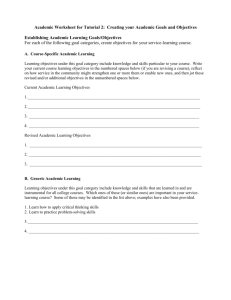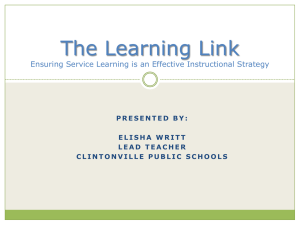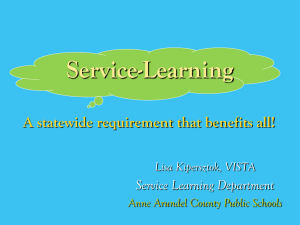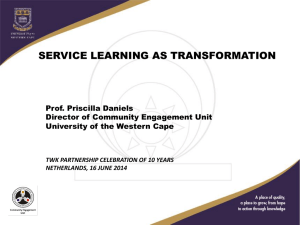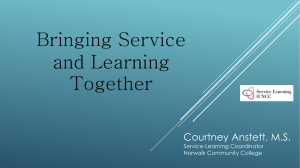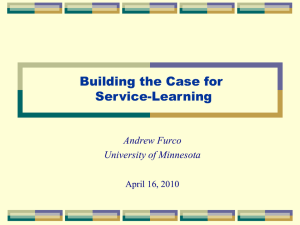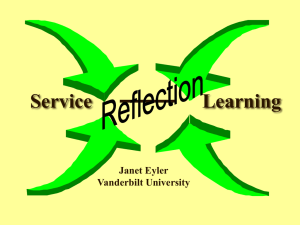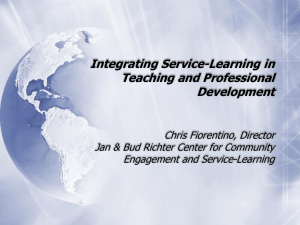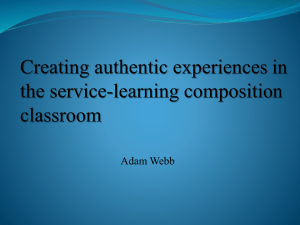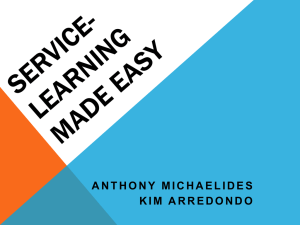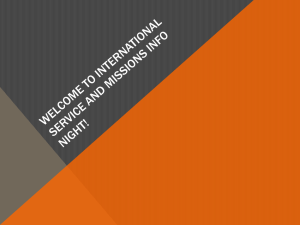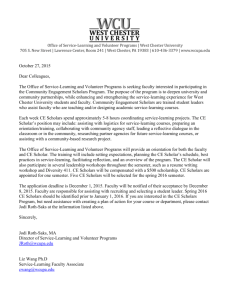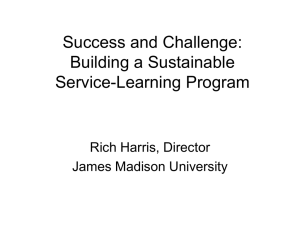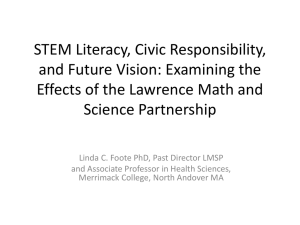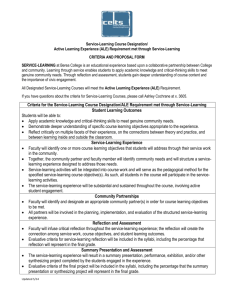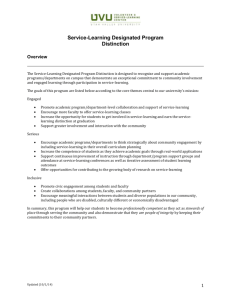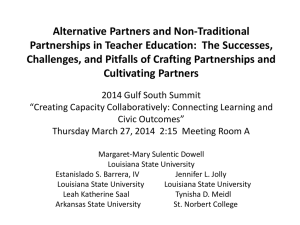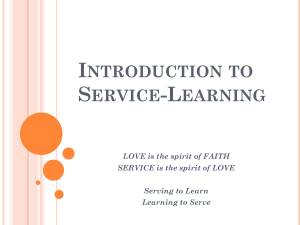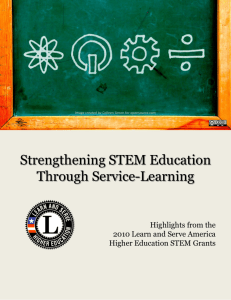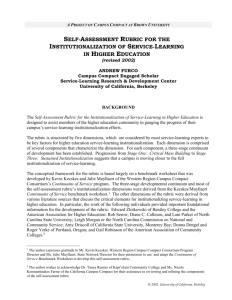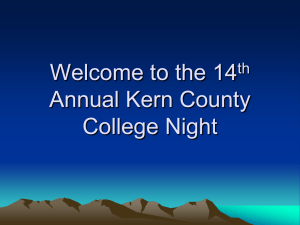STEM/Service-Learning Information Session
advertisement
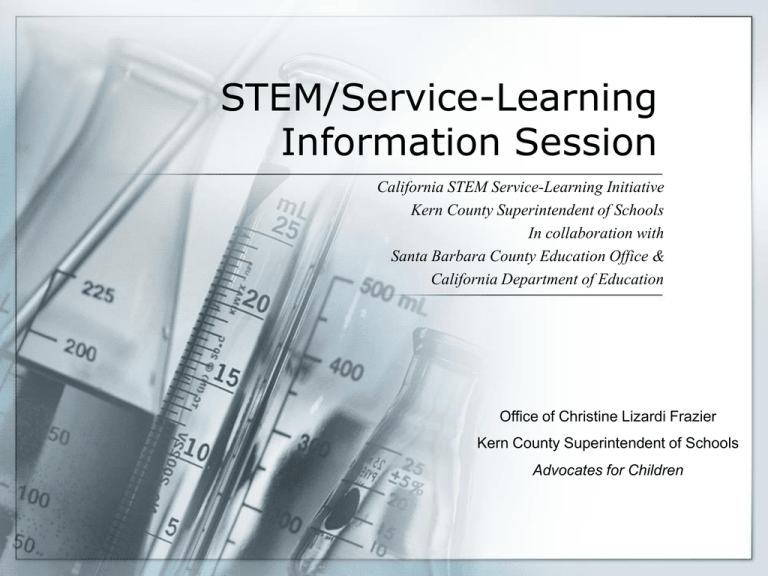
STEM/Service-Learning Information Session California STEM Service-Learning Initiative Kern County Superintendent of Schools In collaboration with Santa Barbara County Education Office & California Department of Education Office of Christine Lizardi Frazier Kern County Superintendent of Schools Advocates for Children Introductions Name School Subject KernServe Initiative Michael Figueroa KernServe Program Manager KernServe Initiative Districts: Maricopa, Richland, Wasco Elementary, Kern High, Tehachapi, Fruitvale, Southern Kern, Delano High, KCSOS Court & Community Schools KernServe provides professional development and technical assistance, mini-grants, transportation, and capacity building for service-learning in the school districts listed above California STEM Service-Learning Initiative Information Session Summary Funding Purpose STEM Service-Learning Application Process Requirements Questions Funding Purpose The California Science, Technology, Engineering, and Math (STEM) ServiceLearning Initiative seeks to promote STEM-based service-learning opportunities for all students-especially female and underrepresented minorities. The initiative also looks to increase student interest in pursuing STEM-related careers and postsecondary study. For more information, visit http://www.calstem.org/ What is STEM? Science Technology Engineering Math What is Service-Learning? Service-Learning is an instructional strategy that connects academic curriculum to meeting real community needs through service. This methodology allows students the opportunity to learn and develop through meaningful experiences and active civic participation. •Integrated Learning •High-Quality Service •Collaboration •Student Voice •Civic Responsibility •Reflection •Evaluation Review Handout: Seven Elements of High-Quality Service-Learning Community Service vs Service-Learning Community Service •Usually done on a co-curricular basis for personal growth or for group bonding. •Does not usually carry academic credit. •Planning is often the responsibility of those providing the service. •Often viewed as a project, program, or experience, rather than a pedagogy. •While "student learning" is likely to take place, it is not an intentional or primary focus. Service-Learning •Integrates academic study with community service in a way that makes "learning" more intentional (e.g., through reflective writing, group discussions, and other activities). •Incorporates the concept of "mutuality" (i.e., several parties are included in the planning of the program, such as faculty, students, and those being "served"). •Fosters participant learning about the larger social issues that are driving the need for service. •Frames "service" in terms of social justice instead of in terms of charity. •Emphasizes a rhythm of reflection-actionreflection. Community Service vs Service-Learning Community Service vs. Service Learning: Service learning projects emphasize both the service and the learning. By applying classroom content to community settings, service-learning is a way to provide more authenticity and purpose for classroom learning. By contrast, community service emphasizes the habits and skills of volunteerism. Community Service •Students participate as volunteers in a planned community clean-up. Service-Learning •Students feel their local park is unsafe because of drug and alcohol users. Students organize a park clean-up event with local waste management. Garbage is separated into two categories: 1) drug and alcohol related 2) non-drug and alcohol related. Garbage is measured and results are graphed. Students design a powerpoint presentation to present to Parks and Recreation Board in an attempt to pass an ordinance that requires a permit for alcohol use at the park. Application of Intent to Participate Components • Contact Information • Principal/Administrator Approval • Project Title • Two Content Standards Addressed in Project • Brief Description of Project (150 words or less) Application Process Applications are due September 24, 2010 by 5pm (please ignore the September 20 deadline on application). The applications will be reviewed by the team in Santa Barbara. Teachers must submit one copy by email to Belinda Sellars at bsellars@sbceo.org AND a SIGNED fax copy to Lorie Flores at 805-563-1103 This is a competitive process (total of 15 spots); however, the counties in Region 8 will work together to accept as many teachers into the network as possible. As a consortium, we encourage all interested teachers to apply. Please refer to Region 8 STEM S-L Consortium Frequently Asked Questions for more information Requirements To receive $750 stipend, teachers must: Submit an application Teach a unit with a focus on energy use, conservation, and/or alternative energy (all STEM related projects will be considered but priority will be given to conservation related projects). Only 6-12 grade teachers will be considered. Participate in the following activities: October Meet and Greet January STEM Training (3 days/expenses covered) Tentative dates Jan 25-27…Aloft Hotel in Rancho Cucamonga. March Telephone Conference April Sharing Questions? Contact Michael Figueroa KernServe Program Manager Kern County Superintendent of Schools School Community Partnerships 1300 17th St – University Square Bakersfield, CA 93301 Phone: 661-636-4487 Fax: 661-636-4329 Email: mifigueroa@kern.org

